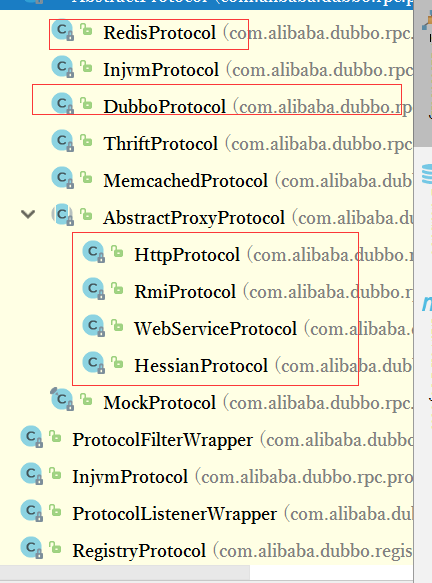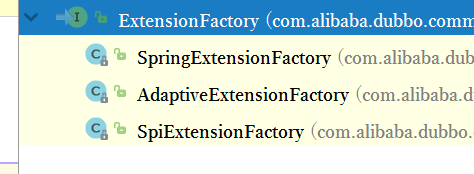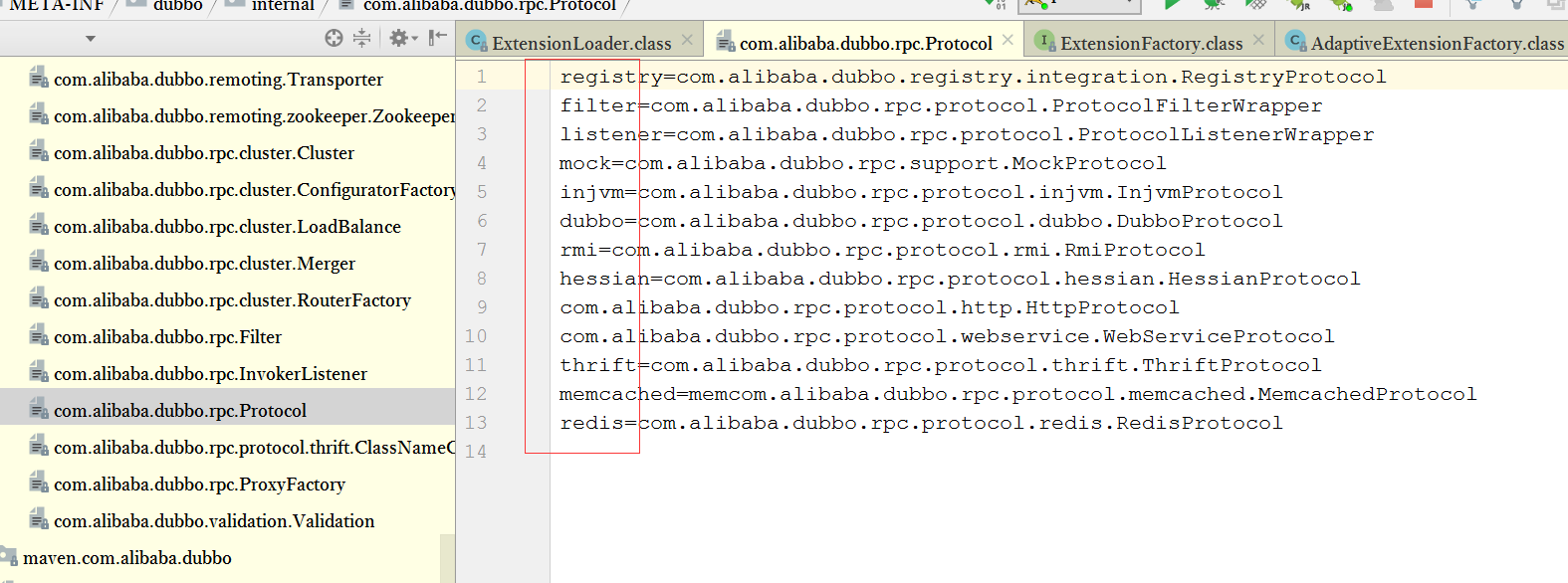dubbo-源码阅读之dubboSpi实现原理
dubboSPI实现思想跟javaspi的思想差不多javaspi是ServiceLoad 而dubbo自己写的是ExtensionLoader
SPI接口定义
@Documented
@Retention(RetentionPolicy.RUNTIME)
@Target({ElementType.TYPE})
public @interface SPI {
String value() default "";//扩展点的key
}
说明:标识接口是否是spi接口。只有spi接口才会去扫描相应的配置文件动态加载
@Documented
@Retention(RetentionPolicy.RUNTIME)
@Target({ElementType.TYPE, ElementType.METHOD})
public @interface Adaptive {
String[] value() default {};//扩展点的key
}
说明:如果打在类上 则这个类是适配器类一个程序(只能有一个),如果打在接口上则需要使用javassitis动态生成适配类。
ExtensionLoader类
静态成员
当前类的所有对象共享
//[1]扫描服务实现的文件存放
private static final String SERVICES_DIRECTORY = "META-INF/services/";
//[2]扫描服务实现的文件存放
private static final String DUBBO_DIRECTORY = "META-INF/dubbo/";
//[3]扫描服务实现的文件存放
private static final String DUBBO_INTERNAL_DIRECTORY = "META-INF/dubbo/internal/";
private static final Pattern NAME_SEPARATOR = Pattern.compile("\\s*[,]+\\s*");
//[4]每个class类都会创建一个对应ExtensionLoader 可以理解成缓存
private static final ConcurrentMap<Class<?>, ExtensionLoader<?>> EXTENSION_LOADERS = new ConcurrentHashMap();
//[5]每个class类的对象缓存
private static final ConcurrentMap<Class<?>, Object> EXTENSION_INSTANCES = new ConcurrentHashMap();
成员变量
//[6]private final Class<?> type;//当前接口class //[7]创建对象工厂 默认2种实现SPIExtensionFactory SpringExtensionFactory 一个是扫描文件加载 一个在spring容器查找 private final ExtensionFactory objectFactory; //[8]存储每个实现类的key 就是mate-info文件下dubbo=com.alibaba.dubbo.rpc.protocol.dubbo.DubboProtocol private final ConcurrentMap<Class<?>, String> cachedNames = new ConcurrentHashMap(); //[9]指定接口class 扫描到的所有实现类的class private final Holder<Map<String, Class<?>>> cachedClasses = new Holder(); //暂时不造干嘛的 private final Map<String, Activate> cachedActivates = new ConcurrentHashMap(); //[10]存储对应接口class实现类打上了@Adaptive 注解的class private volatile Class<?> cachedAdaptiveClass = null; //[11]存储当前接口class实现类的对象 private final ConcurrentMap<String, Holder<Object>> cachedInstances = new ConcurrentHashMap(); //[12]s private String cachedDefaultName; //[13]缓存适配器实现类的对象 private final Holder<Object> cachedAdaptiveInstance = new Holder(); private volatile Throwable createAdaptiveInstanceError; //[14]缓存扫描实现类 含有构造函数参数包含当前接口class类型的。 没创建一个对象就会遍历然后生成层层代理返回 private Set<Class<?>> cachedWrapperClasses; private Map<String, IllegalStateException> exceptions = new ConcurrentHashMap();
ExtensionLoader加载过程
dubbo里面有大量这样的代码,这些都是dubbo的扩展点。比如我们可以自定义协议。然后在标签配置好我们自定义协议属属性就好了
private static final Protocol protocol = (Protocol)ExtensionLoader.getExtensionLoader(Protocol.class).getAdaptiveExtension();
1.首先我们看Protocol.class是什么
@SPI("dubbo")
public interface Protocol {
int getDefaultPort();
@Adaptive
<T> Exporter<T> export(Invoker<T> var1) throws RpcException;
@Adaptive
<T> Invoker<T> refer(Class<T> var1, URL var2) throws RpcException;
void destroy();
}
2.我们看一下dubbo内置的协议实现

3.断点进入.getExtensionLoader(Protocol.class)
public static <T> ExtensionLoader<T> getExtensionLoader(Class<T> type) {
if (type == null) {
throw new IllegalArgumentException("Extension type == null");
} else if (!type.isInterface()) {//如果不是接口抛出异常
throw new IllegalArgumentException("Extension type(" + type + ") is not interface!");
} else if (!withExtensionAnnotation(type)) {//如果没有打上@SPI注解抛出异常
throw new IllegalArgumentException("Extension type(" + type + ") is not extension, because WITHOUT @" + SPI.class.getSimpleName() + " Annotation!");
} else {
//尝试从缓存中获取ExtensionLoader 静态成员[4]变量
ExtensionLoader<T> loader = (ExtensionLoader) EXTENSION_LOADERS.get(type);
if (loader == null) {
//创建一个对应类型ExtensionLoader并缓存
EXTENSION_LOADERS.putIfAbsent(type, new ExtensionLoader(type));
//返回
loader = (ExloadertensionLoader) EXTENSION_LOADERS.get(type);
}
return loader;
}
}
4.我们进入new ExtensionLoader(type)构造函数看做了什么
private ExtensionLoader(Class<?> type) {
this.type = type;//先把当前class存起来 对应成员变量[6]
/**首先判断当前类型是不是加载工厂类型,如果是工厂则为null因为工厂
loader不需要objectFactory。如果不是用同样的方式获取工厂并赋值给laoder的成员变量[7]
**/
this.objectFactory = type == ExtensionFactory.class ? null : (ExtensionFactory) getExtensionLoader(ExtensionFactory.class).getAdaptiveExtension();
}
Protocol.class!=ExtensionFactory.class 所以会执行(ExtensionFactory) getExtensionLoader(ExtensionFactory.class).getAdaptiveExtension()
(ExtensionFactory) getExtensionLoader(ExtensionFactory.class).getAdaptiveExtension()是不是很熟悉。表示创建对象的工厂 也是我们可以自定义的。
4.我们看一下ExtensionFactory
@SPI
public interface ExtensionFactory {
<T> T getExtension(Class<T> var1, String var2);
}
可以发现也是一个SPI接口
5.ExtensionFactory 实现类

6.SpringExtensionFactory
会根据name在spring容器里面找
public <T> T getExtension(Class<T> type, String name) {
Iterator i$ = contexts.iterator();
while(i$.hasNext()) {
ApplicationContext context = (ApplicationContext)i$.next();
if (context.containsBean(name)) {
Object bean = context.getBean(name);
if (type.isInstance(bean)) {
return bean;
}
}
}
return null;
}
7.SpiExtensionFactory
public <T> T getExtension(Class<T> type, String name) {
if (type.isInterface() && type.isAnnotationPresent(SPI.class)) {
ExtensionLoader<T> loader = ExtensionLoader.getExtensionLoader(type);
if (loader.getSupportedExtensions().size() > 0) {
return loader.getAdaptiveExtension();
}
}
return null;
}
等同于getExtensionLoader(ExtensionFactory.class).getAdaptiveExtension()
8.AdaptiveExtensionFactory
@Adaptive
public class AdaptiveExtensionFactory implements ExtensionFactory {
private final List<ExtensionFactory> factories;//存放了上面2种适配器的实现
public AdaptiveExtensionFactory() {
ExtensionLoader<ExtensionFactory> loader = ExtensionLoader.getExtensionLoader(ExtensionFactory.class);
List<ExtensionFactory> list = new ArrayList();
Iterator i$ = loader.getSupportedExtensions().iterator();
while(i$.hasNext()) {
String name = (String)i$.next();
list.add(loader.getExtension(name));
}
this.factories = Collections.unmodifiableList(list);
}
//会遍历SPIFactory和SpringFactory找到对应的key的bean
public <T> T getExtension(Class<T> type, String name) {
Iterator i$ = this.factories.iterator();
Object extension;
do {
if (!i$.hasNext()) {
return null;
}
ExtensionFactory factory = (ExtensionFactory)i$.next();
extension = factory.getExtension(type, name);
} while(extension == null);
return extension;
}
}
这个类打上了@Adaptive 表示是适配器类
9.getAdaptiveExtension()
回到我们前面 ExtensionLoader.getExtensionLoader(type) 只是单例创建一个对应接口class的Loader 真正加载在getAdaptiveExtension()
public T getAdaptiveExtension() {
Object instance = this.cachedAdaptiveInstance.get();
if (instance == null) {
if (this.createAdaptiveInstanceError != null) {
throw new IllegalStateException("fail to create adaptive instance: " + this.createAdaptiveInstanceError.toString(), this.createAdaptiveInstanceError);
}
Holder var2 = this.cachedAdaptiveInstance;
synchronized (this.cachedAdaptiveInstance) {
instance = this.cachedAdaptiveInstance.get();
//首先判断这个loader有没有默认的适配器类 如果没有 则加载(也可以理解成是否加载过一次了。因为每次加载都会生成一个适配器类)
if (instance == null) {
try {
instance = this.createAdaptiveExtension();
//这里就是加载过后赋值 上面的判断,第二次再获取就直接从缓存里面拿 对应成员变量[10]
this.cachedAdaptiveInstance.set(instance);
} catch (Throwable var5) {
this.createAdaptiveInstanceError = var5;
throw new IllegalStateException("fail to create adaptive instance: " + var5.toString(), var5);
}
}
}
}
return instance;
}
10.再进入这个方法this.createAdaptiveExtension()
private T createAdaptiveExtension() {
try {
return this.(this.getAdaptiveExtensionClass().newInstance());
} catch (Exception var2) {
throw new IllegalStateException("Can not create adaptive extenstion " + this.type + ", cause: " + var2.getMessage(), var2);
}
}
1.先调用this.getAdaptiveExtensionClass()获取一个class
2.再创建.newInstance()反射创建实例
3.injectExtension再将实例交给这个方法处理
11.1 先看getAdaptiveExtensionClass
private Class<?> getAdaptiveExtensionClass() {
this.getExtensionClasses();
return this.cachedAdaptiveClass != null ? this.cachedAdaptiveClass : (this.cachedAdaptiveClass = this.createAdaptiveExtensionClass());
}
11.1.1 getExtensionClasses
private Map<String, Class<?>> getExtensionClasses() {
//对应成员变量9
Map<String, Class<?>> classes = (Map) this.cachedClasses.get();
if (classes == null) {//判断是否加载过了 如果加载过了直接返回
Holder var2 = this.cachedClasses;
synchronized (this.cachedClasses) {
classes = (Map) this.cachedClasses.get();
if (classes == null) {
classes = this.loadExtensionClasses();
this.cachedClasses.set(classes);//对应上面的判断加载后设置到缓存
}
}
}
return classes;
}
11.1.1.1this.loadExtensionClasses()
private Map<String, Class<?>> loadExtensionClasses() {
SPI defaultAnnotation = (SPI) this.type.getAnnotation(SPI.class);
if (defaultAnnotation != null) {
String value = defaultAnnotation.value();
if (value != null && (value = value.trim()).length() > 0) {
String[] names = NAME_SEPARATOR.split(value);
if (names.length > 1) {
throw new IllegalStateException("more than 1 default extension name on extension " + this.type.getName() + ": " + Arrays.toString(names));
}
if (names.length == 1) {
this.cachedDefaultName = names[0];
}
}
}
Map<String, Class<?>> extensionClasses = new HashMap();
//dubboSPI类信息存放目录 逐个加载一遍
this.loadFile(extensionClasses, "META-INF/dubbo/internal/");
this.loadFile(extensionClasses, "META-INF/dubbo/");
this.loadFile(extensionClasses, "META-INF/services/");
return extensionClasses;
}
11.1.1.1.1 loadFile
代码太长 截取部分关键代码
//判断实现类是否打上了Adaptive注解
if (clazz.isAnnotationPresent(Adaptive.class)) {
if (this.cachedAdaptiveClass == null) {
//如果打上了存入成员变量[10]
this.cachedAdaptiveClass = clazz;
} else if (!this.cachedAdaptiveClass.equals(clazz)) {
throw new IllegalStateException("More than 1 adaptive class found: " + this.cachedAdaptiveClass.getClass().getName() + ", " + clazz.getClass().getName());
}
} else {
try {
//这里是判断实现类是否有包含当前类型的构造函数。
clazz.getConstructor(this.type);
Set<Class<?>> wrappers = this.cachedWrapperClasses;
if (wrappers == null) {
this.cachedWrapperClasses = new ConcurrentHashSet();
wrappers = this.cachedWrapperClasses;
}
//如果有存入代理类集合
wrappers.add(clazz);
} catch (NoSuchMethodException var27) {
遍历扫描spi文件扫描类信息 我们来看一下spi文件到底是什么

是不是跟javaspi一样 只是dubbo的多了一个key=类名 可以存到成员变量[9]的key就是他。根据key可以快速找到对应的实现类
11.2 我们回到11.1那里继续往下看
return this.cachedAdaptiveClass != null ? this.cachedAdaptiveClass : (this.cachedAdaptiveClass = this.createAdaptiveExtensionClass())
这里会有一个问题。留意 11.1.1.1.1 如果当打上了 注解之后cachedAdaptiveClass 这个就不会为空 直接返回到10.injectExtension 方法创建对应的实例
11.3 createAdaptiveExtensionClass()
调用这个方法 是spi接口没有实现类打上Adaptive接口才会走
private Class<?> createAdaptiveExtensionClass() {
String code = this.createAdaptiveExtensionClassCode();
ClassLoader classLoader = findClassLoader();
Compiler compiler = (Compiler)getExtensionLoader(Compiler.class).getAdaptiveExtension();
return compiler.compile(code, classLoader);
}
这个方法就是通过javassist动态生成适配器类的class 我找了几个动态生成的代码一看就懂啦 现在我吧code变量的值复制几个出来
首先Protocol 的实现类都没有打上Adaptive 所以会动态生成适配器类
package com.alibaba.dubbo.rpc;
import com.alibaba.dubbo.common.extension.ExtensionLoader;
public class Protocol$Adpative implements com.alibaba.dubbo.rpc.Protocol {
public void destroy() {
throw new UnsupportedOperationException("method public abstract void com.alibaba.dubbo.rpc.Protocol.destroy() of interface com.alibaba.dubbo.rpc.Protocol is not adaptive method!");
}
public int getDefaultPort() {
throw new UnsupportedOperationException("method public abstract int com.alibaba.dubbo.rpc.Protocol.getDefaultPort() of interface com.alibaba.dubbo.rpc.Protocol is not adaptive method!");
}
public com.alibaba.dubbo.rpc.Exporter export(com.alibaba.dubbo.rpc.Invoker arg0) throws com.alibaba.dubbo.rpc.Invoker {
if (arg0 == null) throw new IllegalArgumentException("com.alibaba.dubbo.rpc.Invoker argument == null");
if (arg0.getUrl() == null)
throw new IllegalArgumentException("com.alibaba.dubbo.rpc.Invoker argument getUrl() == null");
com.alibaba.dubbo.common.URL url = arg0.getUrl();
String extName = (url.getProtocol() == null ? "dubbo" : url.getProtocol());
if (extName == null)
throw new IllegalStateException("Fail to get extension(com.alibaba.dubbo.rpc.Protocol) name from url(" + url.toString() + ") use keys([protocol])");
com.alibaba.dubbo.rpc.Protocol extension = (com.alibaba.dubbo.rpc.Protocol) ExtensionLoader.getExtensionLoader(com.alibaba.dubbo.rpc.Protocol.class).getExtension(extName);
return extension.export(arg0);
}
public com.alibaba.dubbo.rpc.Invoker refer(java.lang.Class arg0, com.alibaba.dubbo.common.URL arg1) throws java.lang.Class {
if (arg1 == null) throw new IllegalArgumentException("url == null");
com.alibaba.dubbo.common.URL url = arg1;
String extName = (url.getProtocol() == null ? "dubbo" : url.getProtocol());
if (extName == null)
throw new IllegalStateException("Fail to get extension(com.alibaba.dubbo.rpc.Protocol) name from url(" + url.toString() + ") use keys([protocol])");
com.alibaba.dubbo.rpc.Protocol extension = (com.alibaba.dubbo.rpc.Protocol) ExtensionLoader.getExtensionLoader(com.alibaba.dubbo.rpc.Protocol.class).getExtension(extName);
return extension.refer(arg0, arg1);
}
}
ProxyFactory 接口的适配器类
package com.alibaba.dubbo.rpc;
import com.alibaba.dubbo.common.extension.ExtensionLoader;
public class ProxyFactory$Adpative implements com.alibaba.dubbo.rpc.ProxyFactory {
public java.lang.Object getProxy(com.alibaba.dubbo.rpc.Invoker arg0) throws com.alibaba.dubbo.rpc.Invoker {
if (arg0 == null) throw new IllegalArgumentException("com.alibaba.dubbo.rpc.Invoker argument == null");
if (arg0.getUrl() == null)
throw new IllegalArgumentException("com.alibaba.dubbo.rpc.Invoker argument getUrl() == null");
com.alibaba.dubbo.common.URL url = arg0.getUrl();
String extName = url.getParameter("proxy", "javassist");
if (extName == null)
throw new IllegalStateException("Fail to get extension(com.alibaba.dubbo.rpc.ProxyFactory) name from url(" + url.toString() + ") use keys([proxy])");
com.alibaba.dubbo.rpc.ProxyFactory extension = (com.alibaba.dubbo.rpc.ProxyFactory) ExtensionLoader.getExtensionLoader(com.alibaba.dubbo.rpc.ProxyFactory.class).getExtension(extName);
return extension.getProxy(arg0);
}
public com.alibaba.dubbo.rpc.Invoker getInvoker(java.lang.Object arg0, java.lang.Class arg1, com.alibaba.dubbo.common.URL arg2) throws java.lang.Object {
if (arg2 == null) throw new IllegalArgumentException("url == null");
com.alibaba.dubbo.common.URL url = arg2;
String extName = url.getParameter("proxy", "javassist");
if (extName == null)
throw new IllegalStateException("Fail to get extension(com.alibaba.dubbo.rpc.ProxyFactory) name from url(" + url.toString() + ") use keys([proxy])");
com.alibaba.dubbo.rpc.ProxyFactory extension = (com.alibaba.dubbo.rpc.ProxyFactory) ExtensionLoader.getExtensionLoader(com.alibaba.dubbo.rpc.ProxyFactory.class).getExtension(extName);
return extension.getInvoker(arg0, arg1, arg2);
}
}
就先复制2个 。注意看标红部分。dubbo动态生成的适配器类是根据url里面的参数来适配对应的处理器 key则是前面2个注解里面的value
getExtension是传入对应的key。直接去成员变量【10】根据key去取
12。回到10 injectExtension方法。根据适配器class反射创建对象后内部做了什么
private T injectExtension (T instance){
try {
if (this.objectFactory != null) {
Method[] arr$ = instance.getClass().getMethods();
int len$ = arr$.length;
for (int i$ = 0; i$ < len$; ++i$) {
Method method = arr$[i$];
//获得对象的set方法
if (method.getName().startsWith("set") && method.getParameterTypes().length == 1 && Modifier.isPublic(method.getModifiers())) {
Class pt = method.getParameterTypes()[0];
try {
String property = method.getName().length() > 3 ? method.getName().substring(3, 4).toLowerCase() + method.getName().substring(4) : "";
//记得这个工厂吗。回到第4步。这里相当于ioc 去spi扫描和根据spring容器找相应的key的对象 注入
Object object = this.objectFactory.getExtension(pt, property);
if (object != null) {
method.invoke(instance, object);
}
} catch (Exception var9) {
logger.error("fail to inject via method " + method.getName() + " of interface " + this.type.getName() + ": " + var9.getMessage(), var9);
}
}
}
}
} catch (Exception var10) {
logger.error(var10.getMessage(), var10);
}
return instance;
}
回到11.3 对应接口没有打上Adaptive注解 最终都是通过javassist生成的动态适配器类。这个类里面都是根据url的对应参数key调用.getExtension(extName)这里面的代码
try {
T instance = EXTENSION_INSTANCES.get(clazz);//根据key获得缓存实例。静态成员存
if (instance == null) {
EXTENSION_INSTANCES.putIfAbsent(clazz, clazz.newInstance());
instance = EXTENSION_INSTANCES.get(clazz);
}
this.injectExtension(instance);//ioc注入
Set<Class<?>> wrapperClasses = this.cachedWrapperClasses;
Class wrapperClass;
//这个wapperClass成员变量[14] 和参考11.1.1.1.1 loadFile
if (wrapperClasses != null && wrapperClasses.size() > 0) {
//这里是装饰者模式 层层代理 最终返回我们的waper代理
for (Iterator i$ = wrapperClasses.iterator(); i$.hasNext(); instance = this.injectExtension(wrapperClass.getConstructor(this.type).newInstance(instance))) {
wrapperClass = (Class) i$.next();
}
}
return instance;
好累啊!
总结一下怎么利用这些扩展
1.创建spi文件 和实现类。然后将我们的实现类添加一个当前扩展接口的构造函数 就能够实现对应扩展的aop
2.创建spi文件和实现类。 对应的我们自定义key 然后在dubbo对应配置 配置我们的key(对了 dubbox的rest协议 可能是根据这个扩展点扩展的哦)
dubbo-源码阅读之dubboSpi实现原理的更多相关文章
- 【Dubbo源码阅读系列】之远程服务调用(上)
今天打算来讲一讲 Dubbo 服务远程调用.笔者在开始看 Dubbo 远程服务相关源码的时候,看的有点迷糊.后来慢慢明白 Dubbo 远程服务的调用的本质就是动态代理模式的一种实现.本地消费者无须知道 ...
- 【Dubbo源码阅读系列】服务暴露之远程暴露
引言 什么叫 远程暴露 ?试着想象着这么一种场景:假设我们新增了一台服务器 A,专门用于发送短信提示给指定用户.那么问题来了,我们的 Message 服务上线之后,应该如何告知调用方服务器,服务器 A ...
- 【Dubbo源码阅读系列】服务暴露之本地暴露
在上一篇文章中我们介绍 Dubbo 自定义标签解析相关内容,其中我们自定义的 XML 标签 <dubbo:service /> 会被解析为 ServiceBean 对象(传送门:Dubbo ...
- 【Dubbo源码阅读系列】之 Dubbo SPI 机制
最近抽空开始了 Dubbo 源码的阅读之旅,希望可以通过写文章的方式记录和分享自己对 Dubbo 的理解.如果在本文出现一些纰漏或者错误之处,也希望大家不吝指出. Dubbo SPI 介绍 Java ...
- Dubbo源码阅读顺序
转载: https://blog.csdn.net/heroqiang/article/details/85340958 Dubbo源码解析之配置解析篇,主要内容是<dubbo:service/ ...
- Dubbo源码阅读-服务导出
Dubbo服务导出过程始于Spring容器发布刷新事件,Dubbo在接收到事件后,会立即执行服务导出逻辑.整个逻辑大致可分为三个部分,第一部分是前置工作,主要用于检查参数,组装URL.第二部分是导出服 ...
- dubbo源码阅读之负载均衡
负载均衡 在之前集群的文章中,我们分析了通过监听注册中心可以获取到多个服务提供者,并创建多个Invoker,然后通过集群类如FailoverClusterInvoker将多个Invoker封装在一起, ...
- dubbo源码阅读之服务导出
dubbo服务导出 常见的使用dubbo的方式就是通过spring配置文件进行配置.例如下面这样 <?xml version="1.0" encoding="UTF ...
- dubbo源码阅读之自适应扩展
自适应扩展机制 刚开始看代码,其实并不能很好地理解dubbo的自适应扩展机制的作用,我们不妨先把代码的主要逻辑过一遍,梳理一下,在了解了代码细节之后,回过头再来思考自适应扩展的作用,dubbo为什么要 ...
随机推荐
- C# 文件的一些基本操作(转)//用C#读写ini配置文件
C# 文件的一些基本操作 2009-07-19 来自:博客园 字体大小:[大 中 小] 摘要:介绍C#对文件的一些基本操作,读写等. using System;using System.IO;us ...
- (Go)11.九九乘法表示例
//九九乘法表 package main import ( "fmt" ) func chengfa() { ; m < ; m ++ { ; n <= m; n++ ...
- PCB 工程系统 模拟windows域帐号登入
一.需求描述: 对于PCB制造企业来说,基本都采用建立共享目享+域名管控权限,好像别的大多数行业都是这样的吧.呵呵 在实际应用中,经常会有这样的问题,自己登入的帐号没有共享目录的权限,但又想通过程序实 ...
- PCB MS SQL 通过表名查询各字段信息和vb.net C# module类代码
正式表:各字段内容获取 ) SET @tabname = 'ppeflow' SELECT @tabname AS '表名' ,(CASE ))+ ')' )) ) )) + ')' )) ) )) ...
- [Apple开发者帐户帮助]四、管理密钥(2)获取密钥标识符
创建JSON Web令牌(JWT)以与启用的服务进行通信时,需要密钥标识符. 获取密钥标识符 在“ 证书,标识符和配置文件”中,选择侧栏中“键”下的“全部”. 在右侧,选择私钥. 密钥标识符显示在密钥 ...
- Jmeter_Beanshell解析并提取json响应
1:前置条件 将fastjson-1.2.49.jar包置于jmeter的lib目录下,并将该jar包添加到测试计划的Library中:否则会报:Typed variable declaration ...
- IP地址库
吐槽 前两天一个线上的IP地址库除了点幺蛾子,一查代码,发现用的库早就不更新了,遂决定换库,有几个方案: 纯真数据库 IPIP数据库 GeoIP 纯真数据库是大码农的福音,免费,但是精度一般:IPIP ...
- C - Anton and Danik
Problem description Anton likes to play chess, and so does his friend Danik. Once they have played n ...
- MVVM实现ViewModel获取View输入验证状态
由于Binding只把Convert成功的值送往Source,当目标中的值Convert失败时Source的值依然是旧值,所以ViewModel必须获取View的输入验证状态,以下是本人的实现. 当“ ...
- HTML+CSS(10)
n 组合选择器 多元素选择器 n 描述:给多个元素加同一个样式,多个选择器之间用逗号隔开. n 举例:h1,p,div,body{color:red;} 后代元素选择器(最常用) n 描述:给 ...
